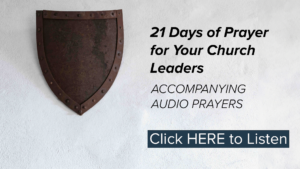Lessons from the Catacombs
A few days ago, I fulfilled a lifetime dream: visiting the catacombs just outside the city of Rome. In response to the long-standing invitation of my friend Gaetano Sottile (Italy for Christ) and the gracious support of numerous churches and individuals, we were in Italy to conduct a pastors’ conference, three regional prayer gatherings, and weekend church services. In this nation where only 1% of the population claims to be evangelical Christian, the need is great and the opportunities to serve through leadership training and prayer mobilization are many.
Understanding the Catacombs
Most people recognize the catacombs as a system of underground tunnels where early Christians buried their dead. From the first to the fifth centuries, 150,000 believers were laid to rest in this intricate 325-mile system of various tomb-lined tunnels, up to five stories deep. There are about 40 different catacomb locations outside Rome, as it was illegal to bury the dead inside the city walls.
Land was expensive around Rome and many Christians were poor. They could not afford regular graves. The soft tufa (volcanic ash) provided a perfect solution, as it was very soft to dig but hardened upon contact with the air.
Strange as it sounds, our tour of the catacombs was a worship experience that moved me through the powerful imagery of the faith and sacrifice of these early Christians. A few key lessons gripped me as we walked through the dark, damp tunnels that echoed the lessons of the unpretentious lifestyle of the early church.
Genuine Hope, Simple Joy
In contrast to the Romans, Christians did not cremate. They believed in the imminent return of Christ, and did not want to destroy the body in light of that hope. Dead bodies were simply wrapped in a burial cloth (following the example of Jesus) and laid in one of the small lateral outcroppings. The opening was then sealed. Some larger outcroppings once contained the bodies of families.
Contrary to fable, the Christians did not go into the catacombs to escape persecution. Rather, this was the place they would gather for The Lord’s Supper, to worship, and to inter those who had “fallen asleep.” The actual Latin name of the catacombs reflected the idea of a dormitory (a place to sleep).
To the modern mind, it may seem morbid to gather, worship, and celebrate Communion in dark underground tunnels where the bodies of dead Christians were hidden away. Yet, for them, this was a declaration of their hope in another life. Our tour guide was emphatic in describing the joy that permeated their gatherings as they set their hearts on the approaching reality of heaven and eternal reward.
It seems that their poverty and simplicity anchored their hearts firmly in the values of eternity – even while gathering in underground rooms with small oil-burning lamps. For us it may be that complexity, materialism, entertainment, and superficial ambition can undermine the reality of a living hope and simple joy in Christ.
The Value of Community
The story of the catacombs is largely about a love for community. Persecution was very real in their day. While they also gathered in fields and homes to worship, the catacombs provided the most undisturbed and intimate place to remember the Lord’s death and the hope of eternal life. To connect in spiritually intimate ways was a lifeline to these believers. To be buried in close proximity to one another as they waited expectantly for the return of Christ was a core value of their faith. Today, we tend to be decidedly individualistic and isolated in our spiritual journeys. This independence robs us of vital spiritual encouragement, health, and power as we seek to affect a culture for the Gospel.
The Power of Sacrifice
Persecution ended in 313 A.D. when Constantine declared Christianity the official religion, but for another 100 years, believers made the catacombs the burial location of choice. For them, it was important to identify with the sacrifice of those who had gone before them. It was a high honor to be laid to rest in close proximity to those spiritual heroes who paid a price, in some cases the ultimate price, for their faith.
This idea moved me. Ours is a culture where stories of sacrifice are soon buried under an avalanche of high-tech information that dominates our lives. We scramble to identify with the rich, the beautiful, the clever, and the famous. I found my heart praying for a renewal of a theology of sacrifice, expressed in tangible ways and a natural expression of our Christ-honoring faith.
Priorities of Prayer and the Word
The early believers connected with one another and shared their stories through symbols left on the walls of the catacombs. Whether it was an engraved fish, dove, or cross, these were badges of glory. Their life in the catacombs was also captured through frescoes of beautiful color and imagery. The oldest and best preserved was a scene of Christians involved in prayer and teaching. As the guide explained, this was the essence of their faith.
I thought of Acts 6:4 where the early leaders declared, “We will give ourselves continually to prayer and the ministry of the word.” I suspect that the beauty and power of the testimonies from the catacombs came from this compelling focus. The sufficiency and strength for sacrifice and spiritual joy came from pure, passionate, truth-infused intimacy.
A Study in Contrasts
From the catacombs, our tour group went immediately to the Basilica of St. John, the cathedral of the Church of Rome and the oldest in Italy. It claims the title of ecumenical mother church among Catholics and was the first one built under Constantine, in the 4th Century. The beauty and magnitude were astounding as we walked among multiplied millions of dollars of opulent art, massive sculptures, and impressive architecture. While I am sure that many sincere Catholics find meaning in all of the history, formality, and abundance of this place, I had the clear sense that we had just gone from movement to monument; from the sacrifice and spiritual simplicity of these early world-changers to the structure and affluence of a highly refined religious system.
Walking among the mammoth ceilings and gold-plated paintings of this basilica, my heart longed for the cool, damp worship of the catacombs. In capturing this contrast, I realized how easily we turn the force of our faith into formalities and fortresses of religion. I ended the day praying that the Lord would give me a fresh, living hope in His soon return, a yearning for a simpler joy, a longing to gather with others who love my Lord, and a compelling desire to value and embrace a greater sacrifice for Christ and His cross.


